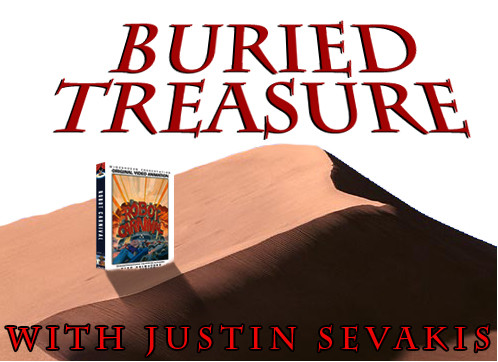Buried Treasure
Fairy Florence
by Justin Sevakis,
Note: As you've probably noticed, there's a lot of stuff going on in our video department right now. There's a lot more coming as well. Since I'm working on so many forthcoming interesting projects for you all, Zac and I have agreed to scale back Buried Treasure to its original biweekly schedule. Hopefully this will allow me to keep the column fresh as well.
It's a personal pet peeve of mine, how many times I've had to compare various artistic anime to the Disney feature Fantasia. Whether I'm talking about an anthology film like Robot Carnival, or an artistic piece like Angel's Egg, chances are that if I'm talking to someone who isn't an otaku, I'm going to eventually have to whip out that comparison. It's seemingly the only piece of pure art animation that most people recognize. The comparison is a necessary evil: no anime looks like Fantasia, or feels like it either. However, if people are going to understand me at all, I have to have a point of reference, no matter how in appropriate.
There is, however, one anime that seems like a feature-length Fantasia segment, featuring all the gorgeous artistry of the seminal Disney film... and most of its faults as well.
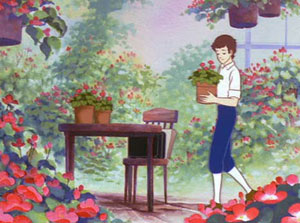 Michael is a student at a prestigious music academy. He's under tremendous pressure to succeed -- both parents are famous musicians -- but the kid just can't concentrate to save his life. Rather, he spends his days in the school greenhouse, caring for the flowers. He plays his oboe for them, tends them, and talks to them. So distracted is he that he's often late to class and finds himself ill-practiced. Unwittingly, he's become the class clown. The professor tries to be patient, but after a particularly disastrous day at orchestra practice, he's finally had enough. "Michael, this isn't for you," he tells the boy. He's to leave the school immediately.
Michael is a student at a prestigious music academy. He's under tremendous pressure to succeed -- both parents are famous musicians -- but the kid just can't concentrate to save his life. Rather, he spends his days in the school greenhouse, caring for the flowers. He plays his oboe for them, tends them, and talks to them. So distracted is he that he's often late to class and finds himself ill-practiced. Unwittingly, he's become the class clown. The professor tries to be patient, but after a particularly disastrous day at orchestra practice, he's finally had enough. "Michael, this isn't for you," he tells the boy. He's to leave the school immediately.
Michael is crushed. Ladling his self esteem off the floor, he stops back at the greenhouse for one last peek at the flowers he loves so intently. And that's when Florence appears to him. She's a tiny, beautiful sprite with a beautiful voice and a gorgeous dance, and immediately Michael is transfixed by her. She gives him a magic wand -- the Semper Wand -- and bids him to come with her to the Flower Kingdom, where they might live happily ever after in escapist harmony. But to get there, he'll have to find Florence without losing the wand to Musica, a mischievous sprite, and his band of lazy blob musicians, the Moko-moko.
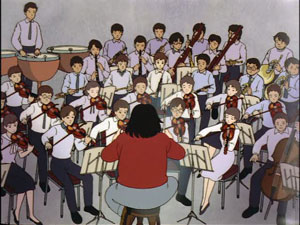 The obvious influence of Fantasia is everywhere, from the calculated and wall-to-wall use of classical themes (performed by the Tokyo Philharmonic Orchestra) to the overwhelming sense of magic. Despite the admittedly childish and trite conceit of the film, the sense of childlike wonder at fantastic worlds is, more or less, unmatched in the world of anime (save, perhaps, for Miyazaki's works). It's a world where flights of fancy, not logic, rule the proceedings. It is, after all, a family art film.
The obvious influence of Fantasia is everywhere, from the calculated and wall-to-wall use of classical themes (performed by the Tokyo Philharmonic Orchestra) to the overwhelming sense of magic. Despite the admittedly childish and trite conceit of the film, the sense of childlike wonder at fantastic worlds is, more or less, unmatched in the world of anime (save, perhaps, for Miyazaki's works). It's a world where flights of fancy, not logic, rule the proceedings. It is, after all, a family art film.
Visually, the film is just incredible. The fact that it was all hand drawn makes it that much more of a marvel. Animated on ones (that is, a cel for every frame, something even Studio Ghibli doesn't usually attempt) and full of lively color and detail, we follow Michael's trek through this bizarre alien world, and watch as his feuding passions, given anthropomorphized shapes, compete for his devotion. Musica does what he can to cause mischief and screw up Florence's plans to live happily with Michael in the flower kingdom, but in the end he gives up easily, and parts from Michael on good terms. There's then a far greater force for them all to contend with.
 The extended musical montages allow for a lot of impressionist leeway. The flower sprites, the elements of music and the Moko-moko spend much of the film moving in large, flowing patterns, at some points channelling Busby Berkeley, and at others Chuck Jones at his most experimental. It's grand and joyous, an animated revue more than a cohesive narrative feature. One sequence involving bubbles even features miniaturized versions of the Sanrio cast of mascots (yes, including Kitty-chan) doing nothing more than bouncing around and being adorable.
The extended musical montages allow for a lot of impressionist leeway. The flower sprites, the elements of music and the Moko-moko spend much of the film moving in large, flowing patterns, at some points channelling Busby Berkeley, and at others Chuck Jones at his most experimental. It's grand and joyous, an animated revue more than a cohesive narrative feature. One sequence involving bubbles even features miniaturized versions of the Sanrio cast of mascots (yes, including Kitty-chan) doing nothing more than bouncing around and being adorable.
Fresh off his work in 1981's Legend of Sirius, Sanrio once again tagged Masami Hata to direct an original story by Sanrio chief executive Shintarō Tsuji. As with the rest of the Sanrio catalog, Tsuji had designs on the international market, and commissioned an English dub for simultaneous release in North America. It was to be the last anime produced by Sanrio Films, as the film's four year production cycle pretty much leveled the company financially. There was simply no way the film was going to break even, and its 1940s-era sensibilities simply didn't connect with modern day audiences. After its release in 1985, the insanely unprofitable anime division was disbanded. Of course, the irony is that Fantasia was also a gigantic bomb upon its initial release, but unlike Fantasia, Fairy Florence never eventually found an audience.
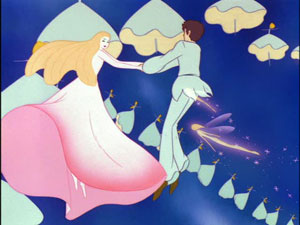 The English dub, while technically well done, quickly descends into the cloying, over-acted performances that one typically finds in American cartoons for younger children. An unnecessary (and particularly mundane sounding) narration is added to explain things that are completely obvious. A few fantasy creatures are renamed as well (for example, Musica becomes Treble -- so they can explain that he is, in fact, "trouble.") Rewrites to the script are minor, but some of the changes don't make a whole lot of sense. ("Let me prove I'm a flower fairy with my fairy dance!" Florence proclaims, and then proceeds to sit down.) Overall, however, it's serviceable if you have a strong tolerance for treacle.
The English dub, while technically well done, quickly descends into the cloying, over-acted performances that one typically finds in American cartoons for younger children. An unnecessary (and particularly mundane sounding) narration is added to explain things that are completely obvious. A few fantasy creatures are renamed as well (for example, Musica becomes Treble -- so they can explain that he is, in fact, "trouble.") Rewrites to the script are minor, but some of the changes don't make a whole lot of sense. ("Let me prove I'm a flower fairy with my fairy dance!" Florence proclaims, and then proceeds to sit down.) Overall, however, it's serviceable if you have a strong tolerance for treacle.
In many ways, Fairy Florence has a lot in common with Masami Hata's American co-production Little Nemo: a gentle telling with beautiful, fluid animation, but marred by a sub-par story and a bland protagonist. In the case of Fairy Florence, however, it's clear that the story was never intended to be the focal point; rather, the explosive visuals, the flowing, frolicking artwork and the gorgeous music is front and center the entire time. It's a night at the opera for the animation lover, and here we have the Japanese animation industry at the top of its form. While the story may be a trifle, the work itself is clearly of anime's highest caliber.
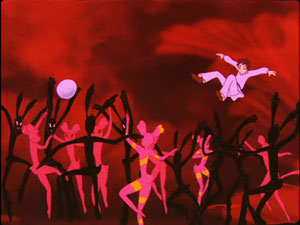 Fairy Florence is, perhaps, not for anime fans so much as fans of animation in general. It fits in there with films like The Thief and the Cobbler, family friendly avant-garde spectaculars that are more for the mothers in the audience, rapt with attention as their children fidget. For the adult who has learned patience, and the child in us who might still be able to experience wonder, however, Fairy Florence is indeed a rare treat. It's the sort of film that, given how expensive they are to produce and how horribly they tend to perform at the box office, I just can't see being made in this day and age, in any country. I think that's a pity.
Fairy Florence is, perhaps, not for anime fans so much as fans of animation in general. It fits in there with films like The Thief and the Cobbler, family friendly avant-garde spectaculars that are more for the mothers in the audience, rapt with attention as their children fidget. For the adult who has learned patience, and the child in us who might still be able to experience wonder, however, Fairy Florence is indeed a rare treat. It's the sort of film that, given how expensive they are to produce and how horribly they tend to perform at the box office, I just can't see being made in this day and age, in any country. I think that's a pity.
| Obscure-O-Meter™ | |
| A | Abundant. Available anywhere that carries anime. |
| C | Common. In print, and always available online. |
| R1 | US release out of print, still in stock most places. |
| R2 | US release out of print, not easy to find. |
| R3 | Import only, but it has English on it. |
| R4 | Import only. Fansubs commonly available. |
| R5 | Import only, and out of print. Fansubs might be out there. |
| R6 | Import long out of print. No fansubs are known to exist. |
| R7 | Very rare. Limited import release or aired on TV with no video release. No fansubs known to exist. |
| R8 | Never been on the market. Almost impossible to obtain. |
| Adapted from Soviet-Awards.com. | |
Where to get it:
The Japanese DVD is absurdly cheap for a region 2 import, it can be had from reputable import shops for less than $20, but unfortunately there is no English on this disc. Fansubs, some of which synchronize the old English dub, can be found online, although they're not particularly easy to find. If you're looking for the ancient VHS dub, that can be found used online for fairly cheap. (Try Amazon Marketplace or half.com)
Screenshots ©1985 Sanrio.
discuss this in the forum (29 posts) |
